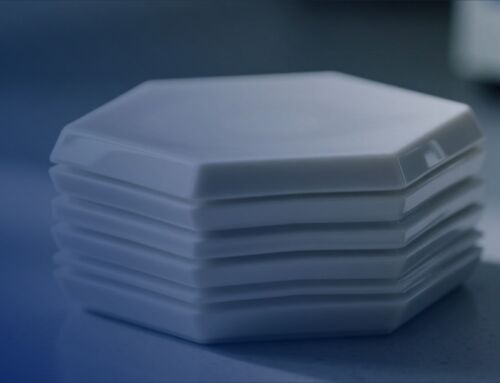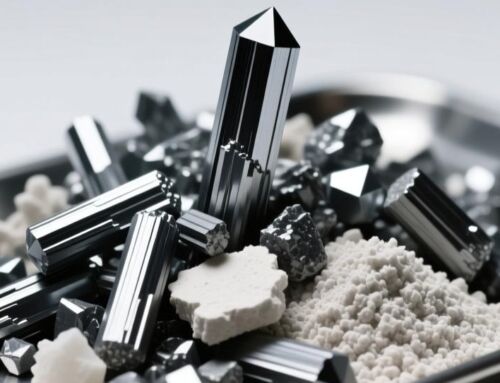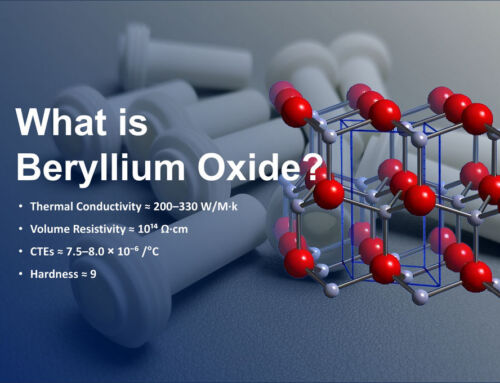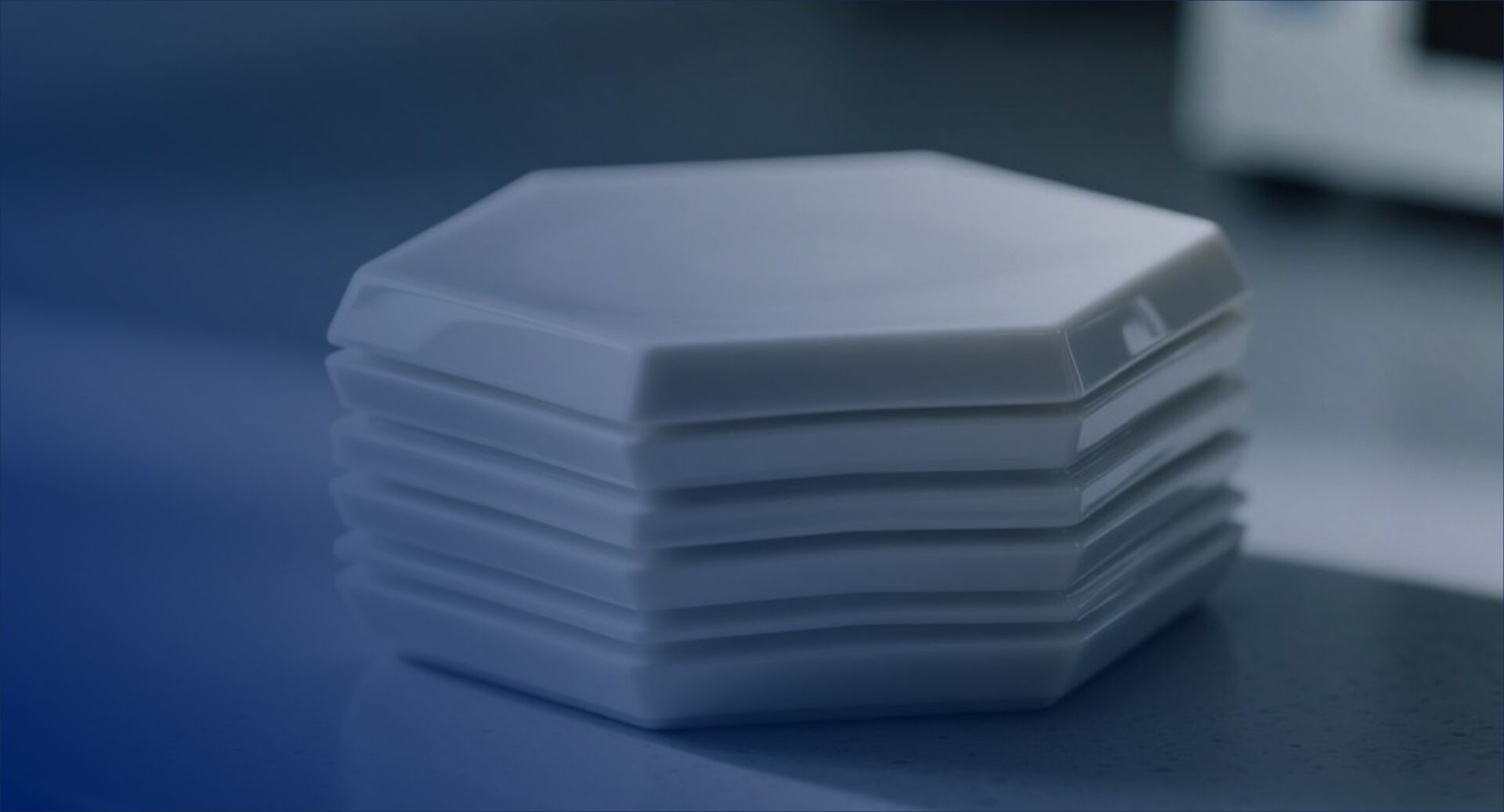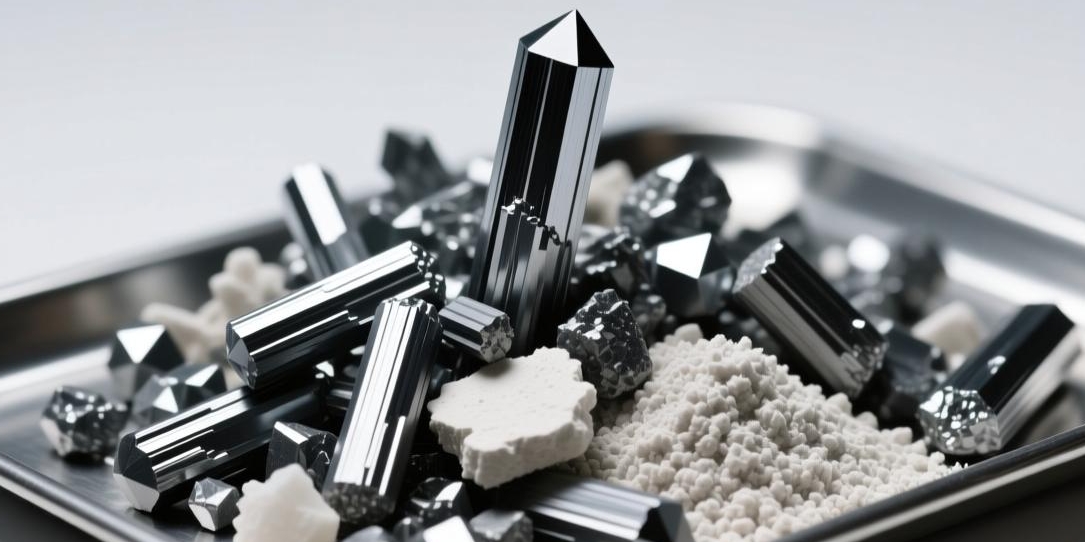ALNセラミックス
ALNセラミックス(窒化アルミニウム・セラミックス)は、卓越した熱的、機械的、電気的特性で有名な先端材料です。技術の進歩に伴い、信頼性の高い性能を発揮しながら過酷な条件にも耐えられる材料への需要が増え続けています。ALNセラミックスは、そのユニークな特性のおかげで、エレクトロニクス、航空宇宙、自動車を含む様々な産業で好ましい選択肢として浮上しています。
この記事では、ALNセラミックスとは何か、その特性、製造プロセス、用途、利点、課題、将来の動向について探っていく。

窒化アルミニウムとは?
窒化アルミニウム(AlN)はアルミニウムと窒素からなる化合物である。20世紀後半に開発されて以来、その優れた特性により大きな注目を集めてきました。脆かったり熱伝導率が低かったりする従来のセラミックスとは異なり、ALNセラミックスは高い熱伝導率と優れた電気絶縁性を兼ね備えているのが特徴です。
歴史的背景
窒化アルミニウムは1950年代に初めて合成されましたが、産業用途におけるその可能性が完全に認識され始めたのは1990年代になってからです。材料科学と製造技術の進歩により、ALNセラミックスは高性能用途でますます実用的になっている。
他のセラミック材料との比較
アルミナや炭化ケイ素のような他のセラミック材料と比較すると、ALNセラミックは優れた電気絶縁性を維持しながら、優れた熱伝導性を提供します。このユニークな組み合わせにより、熱管理と電気絶縁の両方が重要な用途に最適です。
ALNセラミックスの特性
熱特性
ALNセラミックスの特徴の一つは、170W/m・Kを超える高い熱伝導率です。この特性は、電子機器やハイパワー機器など、効率的な放熱が必要な用途において非常に重要です。
熱膨張係数:ALNは低い熱膨張係数を示し、熱衝撃のリスクを低減し、様々な温度下での寸法安定性を保証します。
熱特性の恩恵を受ける用途:電子機器などの産業では、効果的な熱管理がデバイスの寿命と性能に不可欠なヒートシンクや基板に ALN セラミックスが利用されています。
機械的特性
ALN セラミックスは、優れた機械的強度と硬度が特徴です。その高い耐摩耗性は、要求の厳しい用途に適しています。
硬度と耐摩耗性:ALN セラミックスの硬度は、従来の硬質材料に匹敵するため、切削工具や研磨剤用途に最適です。
強度と脆さ:セラミックは高い強度を示す反面、脆くなることもあり、これはセラミック材料に共通する課題です。
エンジニアリング用途への示唆:ALNの機械的特性を理解することは、高温で作動しながら機械的応力に耐えなければならない部品を設計する技術者にとって極めて重要である。
電気的特性
ALNセラミックスは優れた電気絶縁体であり、多くの電子用途に不可欠です。
絶縁特性:誘電率が8~9のALNセラミックスは優れた絶縁性を持ち、高電圧用途に適しています。
絶縁耐力と絶縁破壊電圧:高い絶縁耐力により、ALN セラミックスは、他の材料が電気絶縁破壊により故障するような環境でも優れた性能を発揮します。
エレクトロニクスおよび半導体産業における用途ALNは、LED技術やその他の半導体デバイスの基板製造にますます使用されるようになっている。
化学的安定性
ALNセラミックスは、酸化や腐食に強く、優れた化学的安定性を示す。
酸化と腐食に対する耐性:この特性により、ALNは化学的に侵食性の高い環境でも著しい劣化を起こすことなく使用できる。
化学処理産業における重要性石油化学や医薬品などの分野で、ALNセラミックスは装置の耐久性と信頼性に貢献しています。
ALNセラミックスの製造プロセス
粉体加工技術
窒化アルミニウム・セラミックスの製造には、通常、材料の最終的な特性に影響を与えるいくつかの粉末加工技術が含まれる。
粉末調製の概要アルミニウムと窒素源を注意深く混合し、焼結に適した微粉末に加工する。
焼結プロセスと特性への影響:伝統的な焼結や反応焼結を含むさまざまな焼結方法は、最終製品の密度、微細構造、機械的特性に影響を与える可能性がある。
高度な技術:ホットプレスやスパークプラズマ焼結のような技術革新は、ALNセラミックスの特性を向上させ、微細構造や性能をより細かく制御できるようにするために研究されている。
アディティブ・マニュファクチャリング
3Dプリンティング技術の登場は、窒化アルミニウムセラミックスに新たな道を開いた。
窒化アルミニウムによる3Dプリントの利点:積層造形は、従来の製造方法では実現できなかった複雑な形状や設計を可能にします。
成功したアプリケーションのケーススタディ航空宇宙からヘルスケアまで、さまざまな産業で3Dプリント窒化アルミニウム部品の利用が検討されています。
ALNセラミックスの用途
窒化アルミニウム・セラミックスは、そのユニークな特性により、多様な用途に使用されている:
エレクトロニクスと半導体
ALNセラミックスは、いくつかの理由からエレクトロニクス分野で極めて重要である。
ヒートシンクや基板に使用:熱伝導率が高く、熱を効率的に放散するため、ハイパワーの電子機器に最適。
ハイパワーデバイスにおける役割:現代の電子機器の多くは、電気絶縁性を損なうことなく熱負荷の増大に対応できる材料を必要としている。
航空宇宙産業
航空宇宙分野では、ALNセラミックスはその軽量性と熱管理特性で評価されている。
熱管理への応用:ALNから作られた部品は、航空宇宙用途に重要な熱安定性を提供しながら、極端な温度に耐えることができます。
軽量構造における利点:窒化アルミニウムセラミックスの密度が低いため、航空機全体の重量を減らすことができ、燃料効率の向上につながります。
医療用途
ALNセラミックスは、医療分野でますます用途が広がっている。
歯科用セラミックへの使用その生体適合性と強度は、クラウンやブリッジを含む歯科用途に適している。
バイオ医療機器への応用:ALNセラミックスは、その安定性と耐久性により、様々な医療機器への応用が検討されている。
エネルギー部門
エネルギー分野でも、窒化アルミニウム・セラミックスの特性が役立っている。
エネルギー効率の高いデバイスにおける役割:窒化アルミニウムセラミックスは、電気システムにおけるエネルギー効率の高い部品の開発に貢献している。
再生可能エネルギー技術への応用:その熱的・電気的特性は、太陽電池やエネルギー貯蔵装置に活用されている。
自動車産業
自動車業界では、ALNセラミックスへの関心が高まっている。
高温用途での使用:窒化アルミニウム部品は高温と過酷な環境に耐えることができ、自動車用途に最適です。
性能と耐久性の利点:窒化アルミニウムセラミックスの堅牢な性質は、自動車部品の信頼性と性能の向上に役立ちます。
ALNセラミックスの利点
窒化アルミニウム・セラミックスは、様々な用途で好ましい選択となる数多くの利点を提供します。
主な利点の要約:高い熱伝導性、優れた電気絶縁性、化学的安定性などが際立った特徴である。
他の材料との比較:アルミナや炭化ケイ素と比較すると、窒化アルミニウムセラミックスは熱管理用途で優れた性能を発揮することが多い。
費用対効果と寿命:初期コストは高いものの、窒化アルミニウムセラミックスの寿命と信頼性は、長期的なコスト削減につながります。
AlNセラミックスの将来動向
窒化アルミニウム・セラミックスの将来は、新たな用途と機能強化の発見が続く中で、有望視されている。
研究開発の方向性:加工方法や配合の革新により、さらに優れた性能特性が得られる可能性が高い。
新たな用途産業界がエネルギー効率と耐久性をますます優先するようになるにつれて、窒化アルミニウム・セラミックスは、次世代材料の開発において重要な役割を果たすでしょう。
市場成長と技術進歩の予測:窒化アルミニウムセラミックスの世界市場は、様々な分野での高性能材料に対する需要の増加に伴い、大きく成長すると予想される。
結論
窒化アルミニウム・セラミックスは、材料科学における重要な進歩であり、幅広い用途に適した特性のユニークな組み合わせを提供します。産業が進化し続け、高性能材料への需要が高まる中、窒化アルミニウム・セラミックスは、技術の未来を形作る上で不可欠な役割を果たすだろう。
窒化アルミニウムセラミックスの特性、用途、および関連する課題を理解することは、革新的なソリューションのためにこの先端材料を活用しようとするエンジニアや意思決定者にとって極めて重要です。

